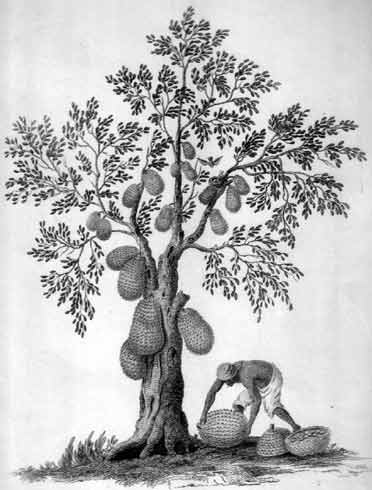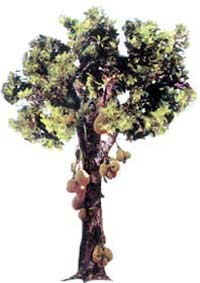Meet the Jak Fruit Tree

The jak fruit is believed to have originated in the tropical rainforests of the Western Ghats in India. It is now considered a native species of the Asian tropics, common in India, Burma, Sri Lanka, the Philippines and Bangladesh. It is also recorded that the jak fruit was introduced to the United States by Sri Lanka (then Ceylon) in the late 19th century.
Jak fruit contains 38 nutrients. It also is rich in curative properties and is used in the treatment of around 30 illnesses. Over one hundred traditional dishes can be prepared using jak and around fifty more can be produced using modern food processing technology.
Let us be a bit more scientific. jak fruit belongs to the genus Artocarpus of the Moraceae family and contains about fifty species. Its botanical name is Artocarpus heterophyllus; also called Artocarpus integra, Artocarpus integrifolia. It is a large evergreen tree.
The bark of the jak is red-brown containing milky latex inside. The leaves are simple, alternate, 10-20 cm long, elliptic or obovate, and those of the young shoots sometimes lobed, dark green and shining on the upper surface, rather rough beneath, base narrowed, main nerves 7 or 8 pairs, petioles 1.2-2.5 cm long, stipules large glabrous soon caduceus. The flowers are unisexual, monoecious, densely crowded on globose or oblong, axillary receptacles often mixed with scales, male flowers perianth 2-4 lobed or partite.

Well-drained, deep alluvial soil is the more suitable for growing jak. It grows at altitudes below 1500m. It can be grown under various agro-ecological conditions. In Sri Lanka it is found in wet zone areas. Land preparation consists merely of digging holes large enough to accommodate the bole of soil that goes with the planting material. It is commonly grown from seeds, which are obtained from mother trees. After extraction, seeds should be planted fresh since they do not retain viability for long periods of time. The plants should be set in the prepared holes 10 to 9cm apart from each other and the roots covered with the top soil mixed with composed or well decomposed manure if available. The soil around the base of the plant should be pressed down to remove large air spaces and to make the plant stand erectly and firmly in the ground.
The stage of maturity at which fruits are harvested depends on the intended use. When used as a vegetable, immature fruits are picked when they are rather dark green. The production of a dull, hallow sound when tapped is considered as the most reliable indicator that the fruit is mature but not ripe. Harvesting at this stage permits fruit to be handled and distributed to distant markets or held for longer periods before consumption. A good tree will yield 400-700 kg per annum. So says the Manual of Jak Cultivation in Sri Lanka published by the Forest Department of Sri Lanka
Udaya, the tireless nutritionist that he is, has also given us the nutritional and therapeutic breakdown of jak, taken from Tables of Food Composition, painstakingly compiled by W.D.A.Perera, Padma M Jayasekera and Sithy Z. Yahaka way back in 1971. Thus:
(Jak, tender portion)
Moisture 84g, Energy 51 kcal, Proteins 2.6g, Fats 0.3g, Carbohydrates 9.4g, Calcium 30 mg, Phosphorus 40mg, Iron 1.7mg, Thiamine 50mcg, Riboflavin 40mcg, Niacin 0.2mg, Vitamin C 14mg.
(Jak, ripe portion)
Moisture 77.2g, Energy 84 kcal, Proteins 1.9g, Fats 0.1g, Carbohydrates 18.9g, Calcium 20 mg, Phosphorus 30mg, Iron 500mg, Thiamine 30mcg, Carotene 54mcg.
(jak, seeds)
Moisture 60.9g, Energy 151 kcal, Proteins 4.3g, Fats 0.4g, Carbohydrates 32.6g, Calcium 35 mg, Phosphorus 126mg, Iron 1.2mg, Thiamine 180mcg, Riboflavin 50mcg, Niacin 0.5mg, Vitamin C 17mg, Carotene 25mcg.
| Living Heritage Trust ©2020 All Rights Reserved |